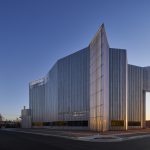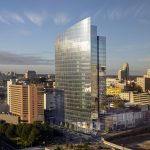Engineering Cities: Nashville
In 2018, 82 people moved to Nashville every day, according to Ashton Real Estate Group. And the city continues to grow as more and more companies take advantage of the low business taxes, no personal income tax, and a skilled workforce.
Nashville – The Place to Be
Alvine Engineering entered the Nashville market as part of the 222 2nd Avenue South project team in 2015. It began a long-term relationship with the city that has included a running list of over 50 projects, equal to over 10,000,000 square feet covering over four square miles of the Nashville Central Business District. From large mixed-use sites like Nashville Yards to the Union Station Hotel to the timber office buildings in the WeHo District, Alvine Engineering’s experience in Nashville is as versatile as the city itself.
Construction can barely keep up with the demand for new homes, offices, and stores. This often leads Nashville projects to issue early release packages. Early release packages allow construction preparations to get underway even before design is finished. At the same time, it challenges engineers to think ahead to how the systems they are designing will be influenced by changing architectural design and how their designs will, in turn, impact structural design.
Nashville’s growth also means that construction is continuous. Old buildings are coming down and new ones are going up constantly in this already dense, bustling area. Tight urban spaces make the construction process difficult for many reasons – closed streets cannot interrupt daily life indefinitely, new buildings cannot cut off old buildings, and so on.
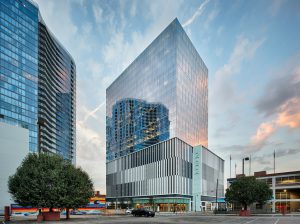
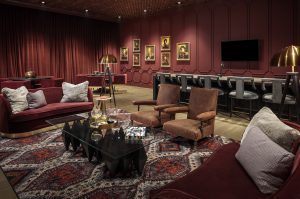
Phasing Can Help
How can the design team overcome these challenges? One way is through carefully phasing the project. Take Fifth + Broadway, for instance, which is a large mixed-use development in Downtown Nashville. The first phase involved the demolition of an old conference center located on the site, groundwork for the below-grade parking garage, and renovation of the neighboring Renaissance Hotel.
However, there was a complication – the old conference center was attached to the Renaissance Hotel. The engineering team had to strategically pull out the building systems for the conference center without taking essential services away from the hotel, which was still fully operational. With the old systems removed, the renovations could begin; including creating an interface to connect the hotel with the new buildings and amenities being constructed.
Phase two involved new construction of an office tower, a luxury residential tower, an indoor/outdoor food hall, and plenty of retail space. That is a lot of area to power, pipe, ventilate, and manage. To pull it off, the site needs great system efficiency.
Infrastructure Efficiency
Each space at Fifth + Broadway needs utilities to support it, but getting power and water from the source to the final destination can be difficult when the site covers 2.2 million square feet. Piping water from one end of the site to the other would waste a lot of energy, which is why the buildings at Fifth + Broadway are served by different sources throughout the area.
This is also a difficult balance, however. “The transformers that serve Fifth + Broadway are massive pieces of equipment that require special considerations to keep them safe and secure, limiting where they can be placed,” explains Tucker Briggs, an electrical designer at Alvine Engineering. “Utility providers also have specific requirements limiting the quantity and placement of transformers that can serve any one site. By strategically placing them and utilizing existing space, we were able to coordinate power for all of Fifth + Broadway using three transformer vaults across the site.”
The local utility department also has its own regulations, which is why maintaining an open dialogue with them is important. By discussing proposed building systems design with the utility company beforehand, they can make suggestions to the engineer that can reduce costly changes further along in the construction process. In some cases, the engineering team may be asked to get creative to work with the utilities already in place, rather than initiating more construction to run new utilities.
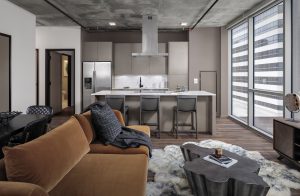

The Future Is Looking Healthy
Nashville is becoming a city of the future with its business leaders coming together to coordinate a healthier environment for people and nature, one building at a time.
“Each project has its own particular goals, but most owners, especially within Downtown Nashville, are striving for healthy buildings with lower energy use intensity (EUI),” explains Brian Hadfield, P.E., F.P.E, LEED AP, WELL AP, an associate principal and mechanical engineer at Alvine Engineering. “Developers and tenants are working together to change the narrative and encourage Nashville to make more healthy, green energy options available.”
Amazon, an anchor tenant in the Nashville Yards development, is one of the companies leading this charge by urging local Nashville utility companies to offer more options for green energy solutions. The push for sustainability is also reflected in the growing number of buildings pursuing LEED certification and use of sustainable resources. The Finery, another of Nashville’s mixed-use developments, is a Timber, Transit, Technology or “T3” project. Still relatively new, T3 projects use wood instead of concrete or steel for the building structure. This provides a number of environmental benefits, including reducing the project’s carbon footprint.
The use of wood can even provide positive mental health benefits by providing a connection to nature, which is a concept found in many healthy buildings. Certification systems such as the WELL Building Standard™ and Fitwel® guide building design to encourage people to be more active and establish healthy habits. In other words, Nashville is moving toward buildings centered on human health that seamlessly coexist with the environment.
One Nashville development that is currently under construction, ONE22ONE, uses ultraviolet lights in the air-handling unit serving the amenity floor and needlepoint bipolar ionization for the unit serving the main entry lobby. Another development still in the design phase, is using bipolar ionization in all air-handling units, increasing filtration to MERV 15 for outside air and MERV 13 for air-handling units on each floor. These measures work to kill pathogens and remove particles before air is delivered to areas where occupants will breathe them in, reducing the spread of illnesses and discomfort from allergens.
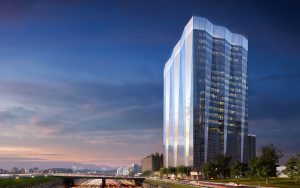
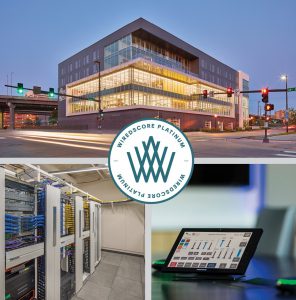
Tech Forward
Technology is also having a big impact on Nashville’s future. Historically known as a music-centric city, Nashville is expanding its focus to include more business. Modern businesses depend on technology to help them reach more customers and make them more efficient. Buildings can support this by better integrating today’s technology and tomorrow’s. However, these tech-savvy buildings can be tough to spot.
Many times a company will sign a lease only to discover that the building does not support a reliable internet connection. This is why many of Nashville’s most influential new buildings are being designed according to WiredScore guidelines. Much like the trust put into LEED, WELL, and Fitwel certifications, people know and trust a building with a WiredScore certification. The high standards and rigorous evaluation process ensure that WiredScore spaces have reliable technology connections.
Measures such as multiple high speed services and diverse points of entry ensure that a space is always connected to fast, reliable internet service. With so many options, it is important to know what you need and where you can save money. IP Design Group has successfully guided eight building owners in locations across the U.S., including three in Nashville, through WiredScore design using an interactive planning session to find the best technology solutions that fit the owner’s overall goal and individual needs.
Imagining the Future
The future of Nashville goes beyond one system or one building. It is about the community coming together to make a commitment to a healthier built environment for people and the planet. The engineering supports this mission by continuing to improve building systems and create more efficient designs. In many ways, Nashville is not imagining the future…it is leading it.


